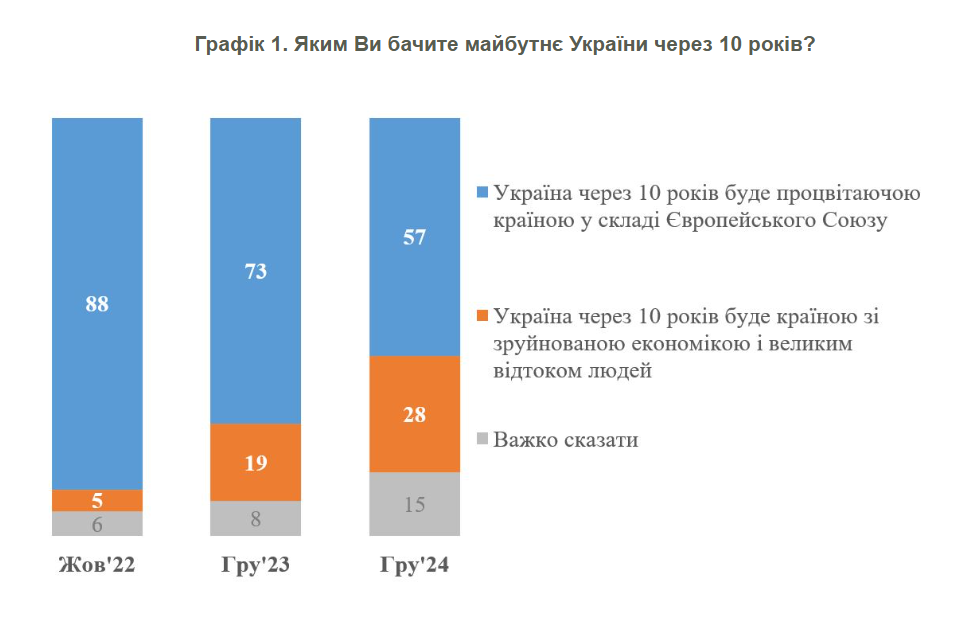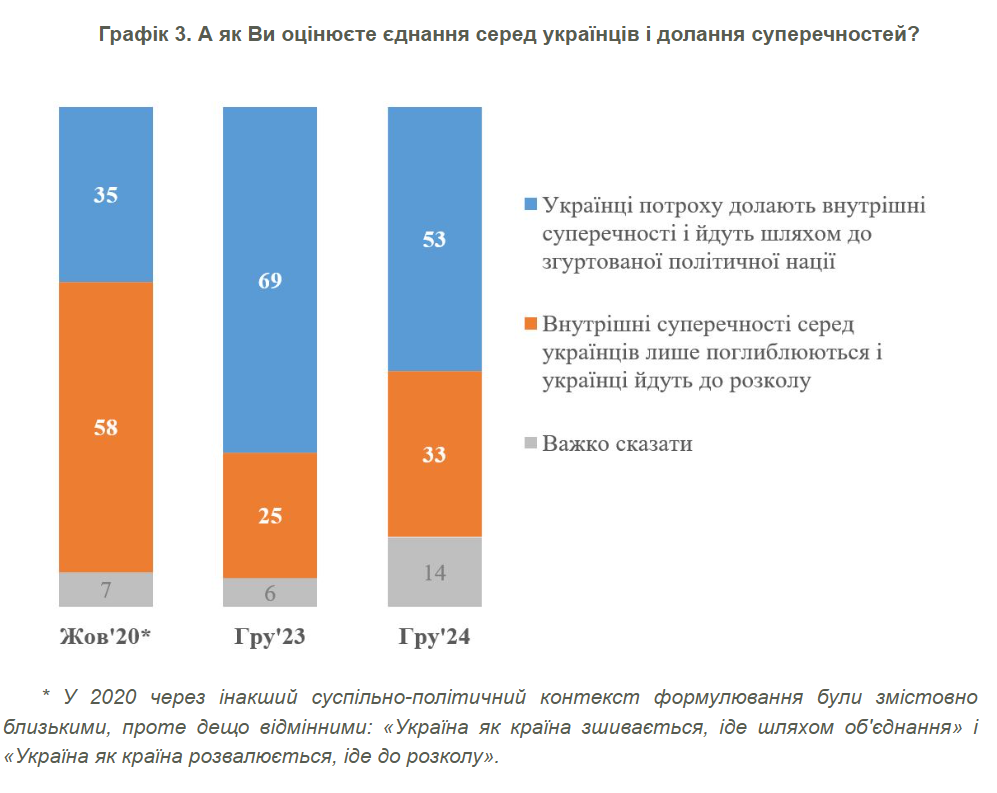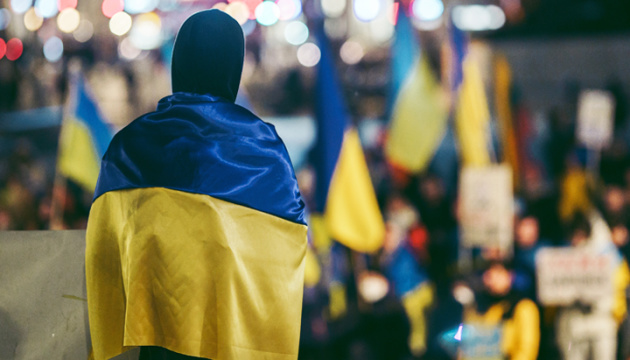“Sociologists note a tendency towards a decrease in the share of those who are optimistic about the future of Ukraine. However, currently the majority of Ukrainians (57%) are generally inclined towards an optimistic view of the country’s future, while the share of pessimists, although significant (28%), is significantly inferior to the share of pessimists.”, — write: www.ukrinform.ua
Sociologists note a tendency towards a decrease in the share of those who are optimistic about the future of Ukraine. However, currently the majority of Ukrainians (57%) are generally inclined towards an optimistic view of the future of the country, while the share of pessimists, although significant (28%), is significantly inferior to the share of pessimists.
“There is a constant tendency to decrease the share of those who are optimistic about the future of Ukraine. If at the end of 2022, 88% believed that Ukraine would be a prosperous country in the EU in 10 years, then by December 2023 their share had decreased to 73%, and by December 2024 to 57%. At the same time, the share of those who believe that Ukraine will have a ruined economy has increased from 5% to 28%. It is important to note that although the share of optimists decreased over the last year by 16 percentage points, not all of them turned into pessimists (their share increased by 9 percentage points). In other words, a significant part of Ukrainians talk more about high uncertainty,” KMIS notes.
 According to sociologists, when analyzing the survey results, one should also focus, in addition to the dynamics, on the actual current indicators. “We see that currently, despite the difficult year and its difficult ending, the majority of Ukrainians (57%) are generally inclined towards an optimistic view of the country’s future. Although the share of pessimists is significant (28%), it is still significantly inferior to the share of pessimists,” the report says.
According to sociologists, when analyzing the survey results, one should also focus, in addition to the dynamics, on the actual current indicators. “We see that currently, despite the difficult year and its difficult ending, the majority of Ukrainians (57%) are generally inclined towards an optimistic view of the country’s future. Although the share of pessimists is significant (28%), it is still significantly inferior to the share of pessimists,” the report says.
At the same time, according to KMIS data, over the past year there have been fewer people who believe that Ukrainians are gradually overcoming contradictions and moving towards a united political nation, from 69% in December 2023 to 53% in December 2024. On the other hand, from 25% to 33%, there were more people who believe that the contradictions are only deepening, and Ukrainians are heading for a split (and also from 6% to 14% there were more people who have uncertain opinions on this issue).
“However, as in the case of the future of the country, it is worth analyzing the current state of affairs separately. Again, in the conditions of difficult and serious challenges (which psychologically break many), we still have about half of Ukrainians (53%) who believe in the movement towards unity, and the share of those who believe in the movement towards division, although it is alarmingly significant , but inferior to conditional optimists. It is also important that the current assessments of unity in society are much better than they were in 2020 (when there was no full-scale invasion yet),” sociologists note.
 KMIS also noted that almost a quarter of those who are optimistic about Ukraine’s future believe that Ukrainians are now heading for a split (13% out of 57%). At the same time, every fifth respondent who believes in the movement towards the unity of Ukrainians, at the same time pessimistically portrays the scenario of the country’s future (10% out of 53%).
KMIS also noted that almost a quarter of those who are optimistic about Ukraine’s future believe that Ukrainians are now heading for a split (13% out of 57%). At the same time, every fifth respondent who believes in the movement towards the unity of Ukrainians, at the same time pessimistically portrays the scenario of the country’s future (10% out of 53%).
“We now have 37% of those with consistently optimistic views, up from 57% in December 2023. By contrast, the share of those with consistently pessimistic views has risen from 10% to 16% over the past year. Most of the increase appears to have been due to an increase in the share of those with undecided or conflicting views. At the same time, although 37%, of course, cannot be considered a high indicator, it is still more than two times more than the share of consistent pessimists (16%), – states the KMIS.
Read also: Hope and anxiety: how Ukrainians feel about the future – poll results If we count among the optimists those who have a positive answer to one question, and to the second – at least “it is difficult to say” (for example, “I believe that in 10 years Ukraine will be in the EU, but it is difficult to say whether we are moving towards unity now” ), and the same procedure is applied to pessimists (one negative answer and one “hard to say”), then in this case 50% will be conditional optimists against 23% who will be conditional pessimists, sociologists conclude.
The Kyiv International Institute of Sociology conducted its own all-Ukrainian public opinion survey “Omnibus”, to which, on its own initiative, it added questions about the level of optimistic/pessimistic attitudes towards the future of Ukraine and the unity of Ukrainians. 985 respondents were interviewed by the method of telephone interviews (CATI) based on a random sample of mobile phone numbers in all regions of Ukraine (territory controlled by the government of Ukraine). The survey was conducted with adults (age 18 and older) citizens of Ukraine who, at the time of the survey, lived on the territory of Ukraine, which was controlled by the government of Ukraine. The sample did not include residents of territories that are temporarily not controlled by the authorities of Ukraine (at the same time, part of the respondents are IDPs who moved from the occupied territories), and the survey was not conducted with citizens who went abroad after February 24, 2022.
Formally, under normal circumstances, the statistical error of such a sample (with a probability of 0.95 and taking into account the design effect of 1.3) did not exceed 4.1% for indicators close to 50%; 3.5% – for indicators close to 25%; 2.5% – for indicators close to 10%; 1.8% – for indicators close to 5%.
Under the conditions of war, in addition to the specified formal error, a certain systematic deviation is added. In general, KMIS believes that the obtained results are still highly representative and allow for a fairly reliable analysis of the public sentiments of the population.
